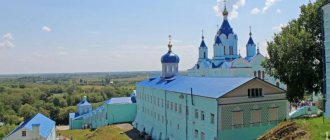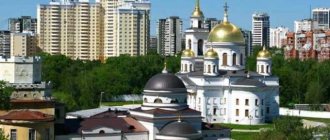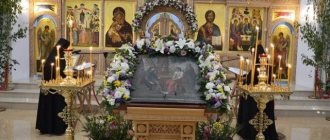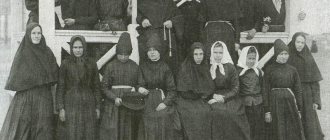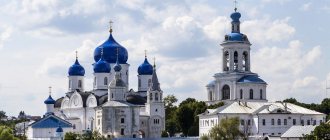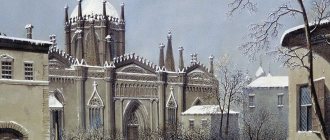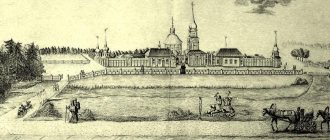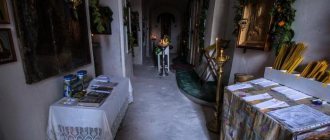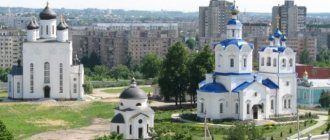| Snetogorsk Monastery |
Pskov Convent in honor of the Nativity of the Blessed Virgin Mary on Snyatnaya Gora,
Pskov diocese
- Address: Russia, 180020, Pskov, st. Snyatnaya Gora, 1
- Tel.; fax: 75-95-72
- Official site:
- On the map: Yandex.Map, Google map
Located 3.5 km from the city center, on the high bank of the Velikaya River, on the picturesque Snyatnaya Gora. The monastery can be reached by bus from the station in about 20 minutes.
Men's monastery
The monastery was founded in the 13th century as a monastery, with the participation of the noble Prince of Pskov Dovmont-Timofey. It received the name Snetogorskoye (sometimes Snetnogorskoye) from its location on Snetnaya (Snyatnaya) Mountain, which in turn was named after the small commercial fish smelt
, which entered the river in abundance. According to some Pskov synodics, the founder of the monastery was Abbot Joasaph, who introduced strict communal rules in the monastery, so that the life of the monks was filled with prayer, abstinence and work. According to another legend, the monastery was founded by monks who arrived from Holy Mount Athos.
On March 4, 1299, Livonian knights attacked Pskov and destroyed and burned the Mirozhsky and Snetnogorsky monasteries, which were located outside the city walls and had no protection. Abbot Martyr Joasaph, 17 monks and presbyter Constantine were burned in the temple. The next day, the valiant Prince of Pskov Dovmont and his retinue defeated the invaders. After the victory, the holy prince ordered a new temple to be erected in the monastery - a stone one. The construction of the stone Cathedral of the Nativity of the Blessed Virgin Mary was completed in 1311, and in 1313 the temple was painted with frescoes. It was one of the first stone temples built in Rus' after a long break in stone construction caused by the Mongol-Tatar invasion.
In the 14th centuries, the Snetogorsky Monastery became the main spiritual center of Pskov. Almost 90 years after the death of the Monk Joasaph, abbot of Snetogorsk, his strict rules were reproduced in the new charter of the Snetnogorsk monastery by Saint Dionysius of Suzdal. In subsequent years, the founders of Pskov desert-dwelling monasticism, the Venerable Euphrosynus of Pskov and Savva Krypetsky, emerged from the walls of the monastery. Until the beginning of the 16th century, the monastery adopted the Keliot charter and contribution of money and lands, which is why the monastery was one of the richest in the city. The monastery was famous in Byzantium and maintained trade relations with Baltic merchants. The Snetogorsky Monastery was the first among other monasteries in the Pskov region to build a courtyard in Pskov - next to Krom, on the banks of the Pskova River. The courtyard has been known since the middle of the 14th century: in 1352, the Church of the Apostle John the Theologian was built on it. The monastery became a traditional place of tonsure for Pskov princes and nobility. Particularly memorable for the monastery was the visit of the Byzantine princess Sophia Fominichna Palaiologos to the monastery in 1472.
In 1493, all the buildings of the monastery burned down. An important stage in the history of the monastery was the construction of stone churches and civil buildings in the first quarter of the 16th century. The renovation of the monastery was associated with the transition of Pskov under the control of the Grand Duke of Moscow. Near the Cathedral of the Nativity of the Virgin, the Church of St. Nicholas the Wonderworker was built in 1519, and around 1526 the Church of the Ascension of the Lord was built, reconstructed and built with a high tent in the 17th century.
In 1581-1582, during the invasion of Pskov by the Polish-Lithuanian troops of Stefan Batory, the monastery was damaged in a fire. During the Time of Troubles, in 1612, the monastery was again attacked by the Poles, and in 1615, under the walls of the monastery there was a camp of Swedish troops, and the monastery itself was occupied by King Gustav Adolf.
In the 17th century, when the development of trade in Pskov contributed to the growth of prosperity, the monastery flourished economically. The monastery then owned about 370 peasant households. The Snetogorsk monastery participated in supplying the army, and also sent peasants living on the monastery lands to the government construction and repair of city walls.
During the Northern War, in 1710, the monastery burned again, and the archive was lost in the fire. After the secularization of the monastic property in 1764, the monastery began to empty and finally fell into disrepair.
Closing
In 1804, the monastery was abolished, and its staff was assigned to the Spaso-Eleazarovsky Monastery. In 1805, the Snetogorsky monastery was given by the government as a country house for the Bishop of Pskov. In 1825, the great poet A.S. Pushkin visited the monastery. During the existence of the bishop's house, services were mainly carried out in the house church of St. Prince Vladimir - the former refectory church of St. Nicholas the Wonderworker.
In 1919, the former Snetogorsky Monastery was included in the protected lists of architectural monuments. In the 1920s, the housekeeper here was the Pskov-Pechersk elder Reverend Simeon (Zhelnin). After 1920, the destruction of the bishop's house began, which also affected the ancient Nativity Cathedral. The temple lost its dome, roofs, and window frames. The territory of the monastery was occupied by a rest house. In 1934, the Ascension Church-bell tower was partially destroyed.
During the Great Patriotic War, the headquarters of the German Army Group North was located here. The territory and buildings of the monastery were landscaped for the residence of German officers. At the same time, a meeting hall was built in the St. Nicholas Church, a wine warehouse and shooting range in the cathedral, and a garage in the ruins of the Ascension Church. During the retreat, German troops disabled the artesian well and water tank that stood above the Church of the Ascension.
In the post-war period, the rest home and children's sanatorium continued to exist. However, the Nativity Cathedral was placed under the jurisdiction of the state authorities for the protection of historical and cultural monuments. Already in the late 1940s and early 1950s, its partial restoration was carried out, which continued in 1985 and is still ongoing.
| Snetogorsk Monastery. Photo from 1986-87. |
Renaissance
On October 2, 1993, the Snetogorsky monastery was revived as a convent. During the years of Soviet power, healthcare institutions on the territory of the monastery remained in ruins and non-residential premises. A few sisters began to restore the monastery on their own. With the blessing of her spiritual mentors, Mother Lyudmila (Vanina) accepted everyone into the monastery, despite the age and infirmities of those who came. Archimandrite Hermogenes (Murtazov) became the confessor of the monastery. People began to flock to the monastery, asking for prayers and blessings in everyday needs and illnesses, for spiritual advice in difficult circumstances, they came from all over Russia and from abroad.
The residential cell buildings were gradually rebuilt, and a new eastern building with the house church of St. Joasaph was erected to replace the old one, which burned down in a big fire in 2002. The Cathedral of the Nativity of the Blessed Virgin Mary, used by the Pskov State Museum-Reserve since November 2001, was finally transferred to the monastery after many years of negotiations with secular authorities. The decision to transfer the cathedral to the Russian Church followed in mid-2012. The monastery’s courtyard was also established in the village of Zamoshye with its own temple of Tikhon of Zadonsk, a dairy farm and agricultural land. Among the sisters' obediences: choir room, prosphora room, bakery, gardeners, seamstresses, historians, refectories, poultry workers, etc. Divine services were held in the refectory of St. Nicholas Church.
| Inspection of the South Tower by Patriarch Kirill. Photo September 3, 2014 |
At the same time, the monastery faced large-scale restoration tasks that required very large funds.
The Cathedral of the Nativity of the Virgin Mary needed immediate restoration of the walls, foundations, and roof, but government assistance remained minimal until the 2010s. The church-bell tower “Ascension-under-bells” lay in ruins. The southern cell building, the ruins of which are covered by temporary outbuildings, as well as the southern tower, located on the emergency slope of the mountain, needed urgent strengthening. The process of collapse of the tower, which stands on a eroding cape, accelerated in January 2006. The federal authorities, after many requests from the monastery, paid attention to the problem of the bank of Snyatnaya Gora; work to strengthen the bank began at the end of 2009, but in 2010 it suddenly stopped, before reaching the South Tower dangerously hanging over the river, and the allocated funds were returned to federal budget. prohibited the continuation of repair work, declaring that the project had been started illegally. After this, despite the efforts of the sisters, the monument continued to collapse. On September 3, 2014, the monastery was visited for the first time by the Primate of the Russian Orthodox Church, Patriarch of Moscow and All Rus' Kirill [1].
Statistics
- OK. beginning XXI - with workers and clergy - approx. 100 inhabitants, of which more than 60 are sisters [2]
- 2015 - approx. one hundred nuns, more than half are elderly nuns, many live in the monastery almshouse [3]
| Mother of God Nativity Cathedral of Snetogorsk Monastery |
Temples, architecture, painting
Our Lady of the Nativity Cathedral
The original wooden church of the monastery burned down during an attack by Livonian knights in 1299. The current single-domed white stone Cathedral of the Nativity of the Blessed Virgin Mary was completed in 1311, and in 1313 it was painted with frescoes. Architecturally, the temple follows the forms of the Transfiguration Cathedral of the Mirozhsky Monastery, but the builders of the Snetogorsk Monastery made their own “amendment” to the composition of the temple. The internal plan of the temple is shaped like a cross inscribed in a quadrangle bounded by walls. In the 16th century, an extension was made to it on the western side of the cathedral. During the Polish-Lithuanian invasion in 1581-1582, when the cathedral was burning, the upper part of the drum collapsed. A year later, the drum was restored, significantly lengthened and decorated with a belt with a Pskov ornament, characteristic of the 14th century. In addition to the main Mother of God Nativity throne, the church has chapels of the prophet John the Baptist and St. Nicholas the Wonderworker. Now the cathedral has the status of a monument of all-Russian significance.
| The descent of the Holy Spirit on the apostles. Detail of a fresco from 1313, Virgin Nativity Cathedral of the Pskov Snetogorsk Monastery |
The Nativity of the Virgin Cathedral is famous for its frescoes, which are the only surviving monument of ancient Russian monumental painting of the first half of the 14th century. The painting dates back to the initial period of the heyday of Pskov fresco. When creating frescoes, Pskov masters used almost all tones of local mineral paints with a predominance of the famous “Pskov blackening”, which gives the paintings a warm color. The bold use of “spaces”—white highlights—gives the figures dynamism. In addition to a bright, picturesque manner, the painting is characterized by a free interpretation of traditional subjects, liveliness of faces and composition. Pskov isographers used not only canonized church subjects, but also apocrypha. The northern wall is occupied by the fresco “The Assumption of the Blessed Virgin Mary”, above the door to the altar is the scene of “The Entry of the Blessed Virgin Mary into the Temple”; the compositions of “The Last Judgment”, with details previously unseen on the frescoes, and “Mid-Pentecost,” which presents a new plot, stand out. The frescoes were badly damaged by fire during the Polish-Lithuanian invasion in 1581-1582. Subsequently, the frescoes in the central part of the building were covered with a new iconostasis, and in open areas they were whitewashed. In 1909, the clearing of Snetogorsk frescoes began, which continues to this day. By our time, the general color scheme of the frescoes has changed greatly, the fragile colors have faded, and the azure background has changed. Since the beginning of the 21st century, the frescoes have been in danger of being lost due to cracks in the walls, which appeared due to the accelerated slide of the monastery into the river.
St. Nicholas Church
A stone church in the name of St. Nicholas the Wonderworker was erected near the Cathedral of the Nativity of the Virgin Mary in 1519. The temple is equipped with a refectory and cellars. Divine services are still held in the church today.
Church of the Ascension - “Snetogorsk Pillar”
The stone church in honor of the Ascension of the Lord “under the bells” was erected around 1526. In the 17th and 18th centuries, the temple was rebuilt more than once, eventually turning into the famous “Snetogorsk Pillar” 63 m high (86 m from the level of the Velikaya River). The temple was destroyed in the pre-war period, under Soviet rule. Now all that remains of the church is the foundation.
House Temple of Joasaph Snetogorsky
Chapel of Moscow Saints
Compounds
- Zamoshskoe metochion with the temple of Tikhon of Zadonsk
- Pskov courtyard with the Church of St. John the Evangelist (inactive)
| Snetogorsk Monastery. Photo ok. beginning XXI century |
Schedule of services
The monastery, revived in 1993, is now active. Guests and pilgrims of the Snetogorsk monastery take with them the most favorable impressions. Divine services are held in the refectory of St. Nicholas Church daily. Anyone can visit them. The schedule of events is always available on the official website of the monastery, as well as in the official group on the social network Vkontakte.
Schedule of services on the monastery website
Morning prayers begin at 7:00 or 8:00, depending on the day of the week, and evening services take place at 17:00. On Thursday, the monastery serves the night sisterhood Liturgy, which can only be attended by sisters of the monastery, so there is no morning service on this day.
Church of St. Nicholas, © A.Savin
Biography facts
There were no priests in his family; only his mother and grandmother were deeply religious. His brother, Father Nikon, became a hierodeacon in the courtyard of the Pukhtitsky Monastery. The sister lives with Hermogenes in the monastery. Their mother Magdalene had three children, all of whom became monastics. My father died in the Great Patriotic War, in the very first days of the war.
There was a church in Chistopol, and Father Hermogenes’ mother bought a house there along with the nuns. Father Hermogenes graduated from school, then worked as a postman, then was drafted into the army in the Baku anti-aircraft artillery. He never took off his pectoral cross. In the church he met nuns from a closed monastery. After demobilization, two old nuns and his choir mother prepared him for admission to the Saratov Theological Seminary.
There, at the seminary, in 1959, Father Hermogenes received the priesthood. 45 years have passed since then.
After the seminary, a year later he entered the Academy in the Trinity-Sergius Lavra (near Moscow). He often visited the Pskov-Pechersky Monastery and even wanted to settle in the parish there, but he received a referral to the Holy Dormition Pukhtitsa Monastery (Estonia), and from 1965 he served there for almost 30 years.
Story
The exact date of foundation of the monastery is not known for certain these days. Also, opinions about the founders are divided. Some historians are inclined to believe that the monastery was founded by the Athonite elders, while the other side claims that the founding father was Abbot Joasaph. The first mention of the temple dates back to 1299, in which the first building was looted and burned, and its abbot and 17 other monks were brutally killed. A year later, construction of a stone temple began on this site, which lasted until 1311.
© SovEst-Ksju
In the XIV-XV centuries. The monastery on Snyatnaya Gora is the main spiritual center of Pskov and its environs. And in the middle of the 14th century. a monastery courtyard was built, which not only strengthened the economic ties of the community with the Pskov settlement, but also maintained active trade relations with merchants from the Baltic states. The monastery was famous among the local nobility. Many Pskov princes and boyars took monastic vows there when retiring.
The location of the monastery on the banks of the Velikaya River at the entrance to Pskov contributed to the fact that many noble people of that time stopped here on their travels. Here you could meet not only famous merchants. Sofia Palaeologus, Grand Duchess of Moscow, also visited the monastery during her trip from Italy to Moscow.
The Livonian War brought numerous losses and destruction to the monastery. First, the monastery was devastated by the troops of King Stefan Batory of Poland, who burned the temple and caused irreparable losses to the priceless frescoes. Later, Pskov was alternately besieged by Cossacks and detachments of the Polish governor Lisovsky. And each time the monastery suffered damage. In 1615, the monastery was occupied by King Gustav Adolf of Sweden, who tried to take Pskov.
Panorama of the courtyard of the Snetogorsk Monastery on Yandex. Maps
Despite the experience, in the 17th century. The monastery is gradually being revived and restoring its buildings. A major role in such rapid development was played by the location of Pskov, which became a major trading center, as well as the extensive farming that the monastery had.
At the beginning of the 18th century. The Northern War dealt a big blow to the monastery's economy. In addition, another fire brought significant losses and burned the archive in which all documents were stored since the very foundation of the monastery. In 1804, the monastery was completely abolished in connection with the policy pursued by Catherine II regarding lands and other church property. And in its place a country house was built for the bishop. And although the monastery was included in the list of ancient monuments subject to state protection, the building was destroyed and ruined for a long time. Thus, the Ascension Church-bell tower, which at one time reached a height of more than 80 meters, was practically dismantled. Now all that remains of it are the ruins of the lower tier.
The Great Patriotic War did not bypass Pskov. The German headquarters of the Army Group North command was located in the monastery. In the monastery buildings there were rooms for housing officers, in the St. Nicholas Church the Germans had a meeting hall, and in the cathedral they stored wine and practiced shooting. During the retreat, the German army destroyed part of the temple structures.
Ruins of the bell tower on the territory of the monastery, © Ksenia Mitrofanova
After the war, the monastery was given over to the needs of a rest home, and after that it was converted into a sanatorium for children. Only the building of the Nativity Cathedral was under the jurisdiction of government agencies responsible for the protection of historical and cultural monuments. Restoration was carried out here, which is still ongoing.
The revival of the monastery took place in 1993, when the monastery was assigned to the Pskov Hierarchy, and a decision was made to open a convent.
Now the monastery has its own courtyard in the village of Zamoshye with a temple in honor of St. Tikhon Zadonsky, located 25 km from Pskov. There is also a dairy farm and agricultural land of the monastery. The monastery also has a shop where they sell their own products, such as milk, potatoes, eggs, cheeses, cottage cheese and much more. There is also a book and icon shop on the territory of the monastery. And at 12:00 and 14:00 there are excursions daily, for which you must register in advance.
View of the monastery from the Velikaya River, © travelbeard
Patriarch
At the beginning of September 2014, Patriarch Kirill personally visited the Snetogorsky Monastery. In the St. Nicholas Church he was greeted by Archimandrite Hermogenes (Murtazov) with the abbess, who noted that for many years the Primate of the Church had visited their monastery for the first time.
Father Hermogenes presented His Holiness with a copy of the icon of the Tikhvin Mother of God as a gift, since the Pskov people often resorted to it for help during the Great Patriotic War.
The Patriarch also made a speech, who admitted that he was glad to visit one of the most ancient monasteries - the Snetogorsk convent of the Pskov diocese, which once played a very important strategic role as a fortress on the path of the invaders, but was then destroyed in a relatively peaceful time, when Soviet organizations began to settle on the territory of the monastery, not sparing architectural monuments.
Snetogorsk Monastery: Hermogenes (Murtazov)
It will be no less interesting to get acquainted with the confessor of the Snetogorsk convent - Father Hermogenes (Murtazov). It is he who bears enormous responsibility for the entire monastic way of life.
As he says about himself, he comes from Tataria, but his surname is not at all Tatar, as it might seem, but real Russian, since it ends with “ov” - Murtazov, in the Tatar version it should end with “in”. Father Hermogenes was born in the Novo-Sheshminsky region, where the Sheshma River flows into the Kama, where the city of Chistopol is located nearby, to which his whole family later moved.
New appointment
About his service as a confessor in a nunnery, he said that you had to be a burning bush in order to burn and not be consumed. For some time, John (Krestyankin) was his spiritual father. Together they decided that Hermogenes needed to leave the monastery and leave, especially after he had a bleeding ulcer open twice. It was then that Father Hermogenes thought that he would no longer be able to endure the service, and therefore decided to retire. His Holiness Patriarch Alexy II, with whom he had good and trusting relations, gave him a wide berth and told him to choose any monastery. But then Vladyka Eusebius arrived and asked Father Hermogenes to help the Snetogorsk monastery. And from that moment he settled there. They constantly received help from the Pukhtitsa Monastery, and gradually the monastery began to be revived. A hotel for pilgrims, a barnyard, etc. were built.
